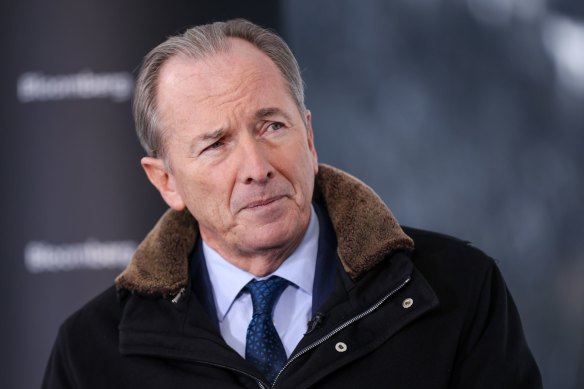The initial $US250 million investment from AustralianSuper is expected to “grow substantially,” according to the pension fund, which has plans to triple its private credit exposure — partly via other similar partnerships — in the coming years.
This year, “there are a lot more managers coming to Australia seeking capital from Aussie funds because this is one of the few areas that’s growing,” Con Michalakis, deputy chief investment officer for $100 billion pension fund Hostplus, said in an interview.
Still, while the surging clout of pensions is giving them access to deals that were once reserved for larger players, there are drawbacks that accompany the growth.

Australia’s super industry is growing rapidly. Credit: Glenn Hunt
Constant inflows place extra pressure on large funds to put that money to work. And as the industry pours money into private assets at home and abroad, it’s facing fresh regulator pressure over valuations of unlisted assets. At the same time, there’s a heightened regulatory focus on performance at home, which is boosting competition for members who can easily switch to rivals.
The trillion-dollar club
The industry’s asset growth has helped funds weather the volatility in global markets as interest rates ratcheted higher, weighing especially hard on fixed-income returns. Total assets have surged by almost $1 trillion in the past five years to stand at $3.5 trillion in the first quarter of 2023.
Loading
Australian law is turbocharging the industry’s inflows. From this month, companies must pay 11 per cent of workers’ salaries into their chosen pension fund. That’s going up to 11.5 per cent next year and rising to 12 per cent in 2025.
As a result, industry assets are forecast to triple to as high as $10.5 trillion by 2040. KPMG expects that the two largest funds could each cross the trillion-dollar mark in that time. The predictions are being made against the backdrop of the economy’s low unemployment, climbing wages and resurgent levels of immigration.
In 2021, Australian pension contributions amounted to 6.9 per cent of gross domestic product, more than three times the OECD average, according to the latest available data. Only Iceland and Switzerland, two significantly smaller pension markets, ranked higher. Australia’s retirement system is now the world’s fifth largest, while its population ranks 54th.
“There are a lot of really significant tailwinds” to the industry’s growth, said Rosemary Shannon, an Edinburgh-based director for UK fund manager Baillie Gifford. She oversees the firm’s ties with super funds, including AustralianSuper, and travels to Australia for up to six weeks at a time.

Melbourne-born Morgan Stanley CEO James Gorman and his investment-management chief Dan Simkowitz regularly speak with superannuation executives in AustraliaCredit: Bloomberg
“We’re seeing the rise of the mega funds — that is something we’ve been keeping an eye on,” Shannon said. “Asset managers can be a part of that and take a chunk of the pie.”
The magnitude of the growth is changing the shape of the Australian economy and its capital markets. Reserve Bank economists last year identified expanding superannuation assets as a key driver behind Australia becoming a net exporter of capital. It’s also meant domestic equity markets are no longer big enough, with pension funds looking to put more investment abroad, especially in private markets.
The $23.6 billion buyout of Sydney Airport in 2021, which was backed by a consortium of funds including AustralianSuper, removed one of the country’s few publicly-traded infrastructure assets and set a record for the biggest cash M&A deal in Australian history.
Talent hunt
Funds are also doing more investing themselves, reducing their roster of external fund managers and increasing the importance for specialist corners such as alternatives. AustralianSuper, for instance, is building out offices in London and New York in a bid to lure talent for its internal teams, while Aware Super plans to open offices overseas.
“It’s a huge market. It’s meaningful and you need to be in it.”
Felicity Walsh, managing director of Franklin Templeton Australia
This has provided an opportunity for Wall Street firms and other asset managers by offering extra services beyond the specific mandates they hold with funds and building out red-hot asset classes like private credit. Pacific Investment Management Co., for one, routinely offers investment research and expertise, part of a growing industry trend.
“There is a shift from many external managers to fewer, deeper partnerships,” said Sam Watkins, head of business for Australia and New Zealand at Pimco, which manages $US1.8 trillion globally and is owned by Allianz. “It has become more common. There is an expectation you will do more,” Watkins said.
For T Rowe Price Group, a $US1.4 trillion Baltimore-based fund manager, Australia’s become a high-priority growth market, said Darren Hall, its head of distribution for Australia and New Zealand. The firm’s taken heed of the growing appetite for alternative assets and two years ago purchased Oak Hill Advisors LP, a private debt specialist with existing links to super funds.
Loading
Meantime, Franklin Templeton’s Felicity Walsh says the opportunities are large for her California-based firm.
“It’s a huge market,” said Walsh, managing director of Franklin Templeton Australia, the local offshoot of the $US1.4 trillion fund manager. “It’s meaningful and you need to be in it.”
Stay connected with us on social media platform for instant update click here to join our Twitter, & Facebook
We are now on Telegram. Click here to join our channel (@TechiUpdate) and stay updated with the latest Technology headlines.
For all the latest Business News Click Here
For the latest news and updates, follow us on Google News.
